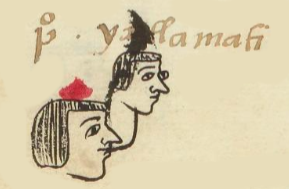Ixtlamati (MH895v)
This black-line drawing of the simplex glyph for the personal name Ixtlamati (perhaps “He is Wise”) is attested here as a man’s name. The glyph shows a man’s face in profile, looking toward the viewer’s right. The left eye (ixtli), which is normally invisible in a profile such as this, has been added to the edge of the face, emphasizing it. It has a phonetic role, indicating that the name starts with (Ix-), but it also has a semantic role, in that the verb ixtlamati has to do with being wise and prudent as a result of lived experience and observation. On top of the man’s head is what appears to be a black obsidian blade (itztli, a near homophone to ixtli), if it is not an ink spill. If it is indeed obsidian, this serves as another phonetic indicator, and, together, the compound that employs the eye (ixtli) and the obsidian blade (itztli, a near homophone) would be fully phonographic.
Stephanie Wood
The name seems to derive from tlamati (also spelled tlamahti, with the glottal stop, “to know something” or to "practice trickery or sorcery." However, the added translation of sorcery and trickery reveals a Christian bias on the part of the friar Alonso de Molina. At the root of tlamati is the verb mati, to know. Marc Thouvenot (2010, 178–181) explains how iximati can become imati, to manage cleverly or create skillfully, and this compares to mati, to know. Imati involves knowing through seeing, much like conocer might indicate in Spanish, and mati is "to know" as in saber in Spanish. In both the verbs starting ix- or i-, the sign for eye is a semantic indicator for a place of wisdom. Thus, vision and knowledge have a close relationship in Nahua culture.
Stephanie Wood
po
Stephanie Wood
1560
Jeff Haskett-Wood
conocimiento, sabiduría, sabios, prudencia, obsidiana, nombres de hombres

ixtlamati, to be wise, prudent, https://nahuatl.wired-humanities.org/content/ixtlamati
ix(tli), eye, https://nahuatl.wired-humanities.org/content/ixtli
tlamati, to know something, or to know sacred powers (verb), https://nahuatl.wired-humanities.org/content/tlamati
tlamatini, a sage, wise person, scholar, https://nahuatl.wired-humanities.org/content/tlamatini
Pedro Ixtlamati
El es Sabio
Stephanie Wood
Matrícula de Huexotzinco, folio 895v, World Digital Library, https://www.loc.gov/resource/gdcwdl.wdl_15282/?sp=863&st=image.
This manuscript is hosted by the Library of Congress and the World Digital Library; used here with the Creative Commons, “Attribution-NonCommercial-ShareAlike 3.0 License” (CC-BY-NC-SAq 3.0).





